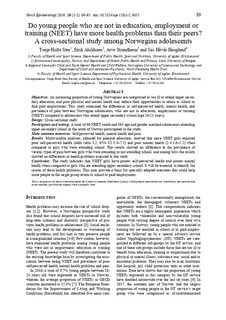| dc.contributor.author | Stea, Tonje Holte | |
| dc.contributor.author | Abildsnes, Eirik | |
| dc.contributor.author | Strandheim, Arve | |
| dc.contributor.author | Haugland, Siri Håvås | |
| dc.date.accessioned | 2019-10-03T07:32:26Z | |
| dc.date.available | 2019-10-03T07:32:26Z | |
| dc.date.created | 2019-06-04T00:57:10Z | |
| dc.date.issued | 2019 | |
| dc.identifier.citation | Norsk Epidemiologi. 2019, 28 (1-2), 89-95. | nb_NO |
| dc.identifier.issn | 0803-2491 | |
| dc.identifier.uri | http://hdl.handle.net/11250/2619945 | |
| dc.description.abstract | Objectives: An increasing proportion of young Norwegians are categorised as too ill to attend upper secondary education, and poor physical and mental health may reduce their opportunities to return to school or find paid employment. This study examined the differences in self-perceived health, mental health, and prevalence of pain between Norwegian adolescents, who are not in education, employment or training (NEET) compared to adolescents who attend upper secondary school (age 16-21 years).
Design: Cross-sectional study.
Participants and setting: A total of 96 NEET youth and 384 age and gender matched adolescents attending upper secondary school in the south of Norway participated in the study.
Main outcome measures: Self-perceived health, mental health and pain.
Results: Multivariable analyses, adjusted for parental education, showed that more NEET girls reported poor self-perceived health (odds ratio 3.2; 95% CI 1.4–7.5) and poor mental health (2.4;1.0–5.2) when compared to girls who were attending school. The results showed no difference in the prevalence of various types of pain between girls who were attending or not attending school, and among boys the results showed no differences in health problems assessed in this study.
Conclusion: The study indicates that NEET girls have poorer self-perceived health and poorer mental health when compared to girls who are attending upper secondary school. It will be essential to identify the causes of these health problems. This may provide a basis for specially adapted measures that could help more people in the target group return to school or paid employment. | nb_NO |
| dc.language.iso | eng | nb_NO |
| dc.publisher | Norwegian Epidemiological Association (NOFE) | nb_NO |
| dc.rights | Navngivelse 4.0 Internasjonal | * |
| dc.rights.uri | http://creativecommons.org/licenses/by/4.0/deed.no | * |
| dc.title | Do young people who are not in education, employment or training (NEET) have more health problems than their peers? A cross-sectional study among Norwegian adolescents | nb_NO |
| dc.type | Journal article | nb_NO |
| dc.type | Peer reviewed | nb_NO |
| dc.description.version | publishedVersion | nb_NO |
| dc.source.pagenumber | 89-95 | nb_NO |
| dc.source.volume | 28 | nb_NO |
| dc.source.journal | Norsk Epidemiologi | nb_NO |
| dc.source.issue | 1-2 | nb_NO |
| dc.identifier.doi | 10.5324/nje.v28i1-2.3055 | |
| dc.identifier.cristin | 1702442 | |
| dc.description.localcode | Copyright (c) 2019 Tonje H. Stea. Open Access. This work is licensed under a Creative Commons Attribution 4.0 International License. | nb_NO |
| cristin.unitcode | 194,65,35,5 | |
| cristin.unitname | RKBU Midt-Norge - Regionalt kunnskapssenter for barn og unge - psykisk helse og barnevern | |
| cristin.ispublished | true | |
| cristin.fulltext | original | |
| cristin.qualitycode | 1 | |

